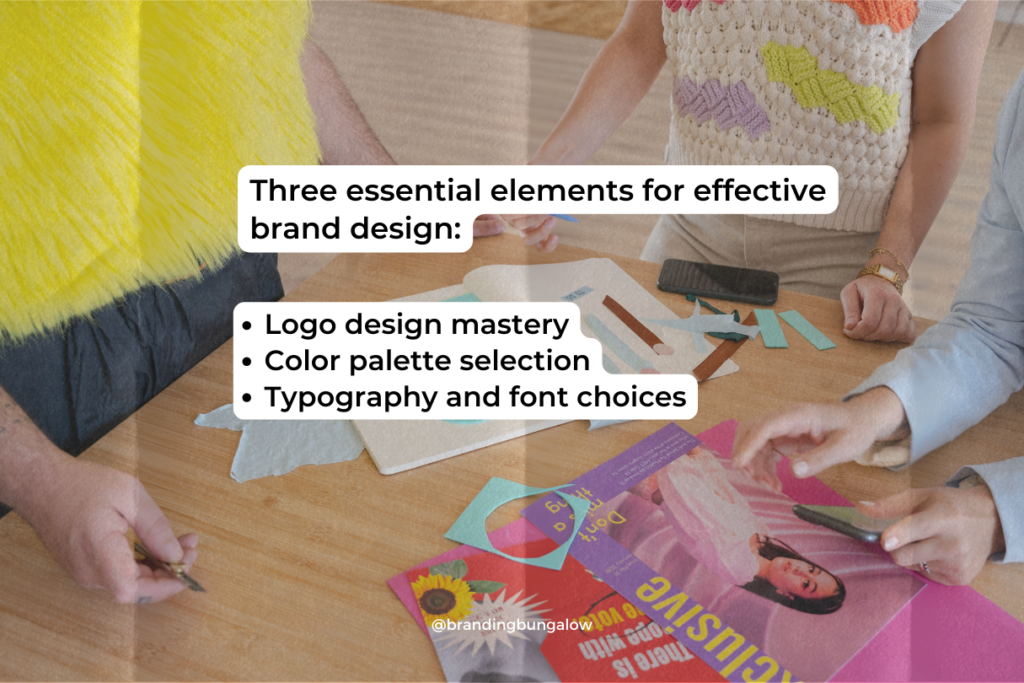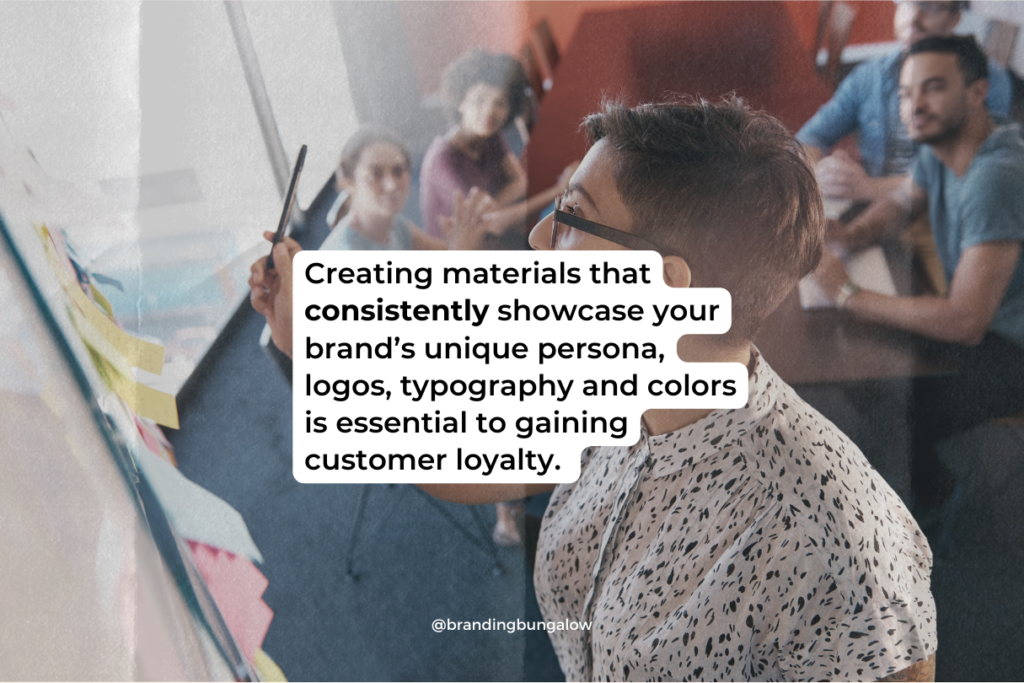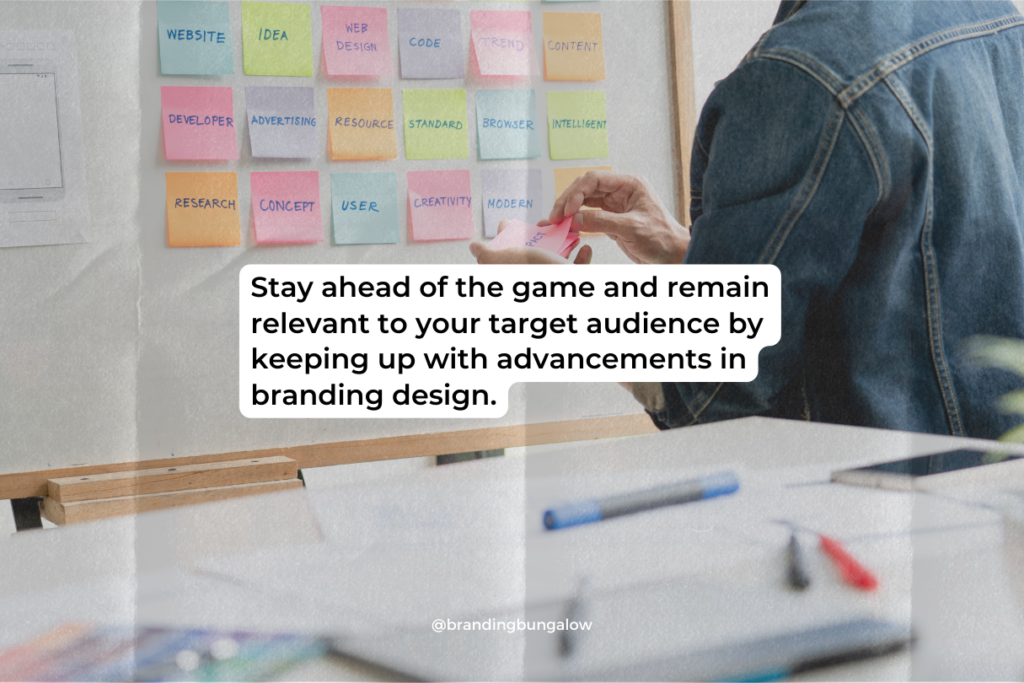Uncover the Secrets to Designing a Strong Brand Identity
Ever wondered what makes some brands stand out from the crowd and stay etched in our minds? It’s their unique and powerful brand identity meticulously crafted through branding design. Ready to learn the secrets of building an unforgettable brand? Let’s get started!
Key Takeaways
- Create a unique and memorable visual identity to captivate customers.
- Master the art of logo design, color palette selection, and typography choices for an impactful brand impression.
- Stay up-to-date with trends & innovations in branding design to remain relevant & create a strong brand identity.
The Essence of Branding Design

The power of effective brand identity design can have a captivating effect on customers, so creating an easily recognizable visual identity with logos, colors and typography is key to successfully conveying the message behind your brand. This investment in branding will build long-term reputation amongst consumers as well as competitors and partners, leading to greater business value overall. All elements need to come together cohesively for it to work properly. Shapes, photography styles, animation layouts, etc., making up the essential components required for forging a memorable presence for any given brand. In order to bring this powerful marketing tool into play, how do we go about crafting such strong identities? We’ll explore what goes into successful branding design here!
The Importance of Visual Identity
Creating a unique visual identity for your brand is essential in order to make it stand out, making sure customers can easily remember it and develop an emotional connection. Your logo should not be the only design element associated with this identification. Other aspects like graphic design also contribute to give character and attractiveness towards its recognition. An example of such could be investing in professional services that help craft elements which set you apart from others in terms of branding.
When designing the identity visuals, consider all components related (extending beyond just one logo) as they play a key role within the success of connecting with potential audiences across multiple marketing areas.
The Connection Between Branding and Marketing
Brand design and marketing are closely related. The establishment of a recognizable brand identity, with consistent visuals and messaging, is crucial for the success of any promotional campaign as it leads to recognition by consumers, setting the business apart from competitors. Market research plays an important role in determining appropriate branding elements that should be incorporated into all aspects of its advertising material.
It’s imperative for businesses to understand how their branding will affect their approach when planning out marketing strategies. Connecting these two entities can prove effective if done right! By incorporating market insights into existing designs, it ensures adherence to both aesthetic requirements but also overall message delivery, which helps create powerful impression on target customers’ mindsets upon interacting with brands materials online or offline.
Key Components of Effective Branding Design

In order to develop an effective brand design, there are three essential elements which need to be taken into consideration: logo design, color palette selection and typography choices. Your logo is the visual representation of your company – it often serves as customers’ first impression. The right choice in colors can give a significant boost towards forming your desired brand identity while picking out appropriate typeface for conveying emotions associated with that particular personality values you wish to project onto consumers makes up another integral part of building the perfect image for people’s recognition. If you get these components just right, not only will potential users respond well when encountering your product, but also differentiate them from others within their scope on the market effectively. Let’s explore each element and find ways how they help construct successful branding strategies!
Logo Design Mastery
Creating an impactful logo is crucial to establishing a brand’s identity and distinguishing it from other companies. It should clearly communicate the company’s values, personality, and aesthetic while being eye-catching enough that people will remember it. A memorable logo helps create a strong brand image for any business as well as offering up visual cues so customers can easily recognize them with others on the market.
A successful symbol needs to capture what makes this particular firm unique – embodying their ethos so one glance expresses everything about who they are – making sure every aspect of its design reflects those qualities seamlessly allows businesses to build recognition within industry or consumers immediately recognize upon seeing it again later down the line.
Color Palette Selection
When constructing a brand’s image, picking the appropriate color palette is essential. It can elicit certain emotions from your target audience and help create the effect you are hoping to achieve. In order to select this ideal hue combination, one should contemplate their desired message as well as reflect upon how cultural characteristics and color psychology come into play when defining your brand’s identity. Remember that while colors have significant power in delivering an effective message about your business or product – it must be done accurately!
Typography and Font Choices
In branding design, typography is a key element to consider. Selecting fonts that accurately reflect your brand’s personality and values creates a strong visual impact and leaves an impression on viewers. When selecting font options for your company, look at readability as well as the way in which they represent the feel of your brand’s persona. It’s important to think about how these characters portray both the image of what they stand for along with its core characteristics such as character traits or beliefs when choosing something suitable for its identity mark.
Building a Unique Brand Identity Through Design

In order to create a unique brand identity, it’s necessary to establish an appealing and consistent personality through marketing collateral that reflects the brand’s values. This is essential for developing emotional connections with customers and ensuring messaging consistency across all channels. To strengthen the recognition of your strong brand, use design elements such as logos, colors and typography consistently throughout branding initiatives – unifying image & message which ultimately leads to greater trust between customer & established name. Ultimately, this will help foster loyalty towards your recognizable strong identity while leading into better promotion outcomes associated with said solidified ‘brand’ mark, building lasting relationships along the way!
Establishing a Brand Personality
The brand identity should be defined well in order to craft a powerful and consistent personality for the company. If it is not clear, customers might face issues with recognizing your values, mission statement or even relating themselves to you as an organization. Hence, constructing accurate brand persona involves understanding core beliefs and goals associated with the target audience along with its individualistic nature which can tremendously increase recognition of your strong presence among consumers influencing their decisions positively towards purchasing from you over others that lack this solidified identity. Crafting marketing content geared around this carefully designed image creates convenience for buyers investing in brands they are familiarized with through various communication mediums such as pamphlets or other visuals representing product offerings made by reliable ones like yours!
Crafting Consistent Marketing Collateral
Using the same fonts, logos, and colors throughout a company’s marketing materials is essential for establishing their visual identity. Crafting thorough brand guidelines helps guarantee that all of the branding elements align with each other in order to help create recognizable visuals which foster trust among consumers. Consistency in design builds recognition around the brand itself. It demonstrates commitment from both customers and creators alike to quality messaging, designs, and objectives associated with that particular entity.
Case Studies: Inspiring Examples of Branding Design

Studying top-notch brand design examples can provide useful points and ideas to create a remarkable brand identity. By analyzing how other successful brands have established their visual presence, messaging, and emotional connection with the public, it is possible to identify elements that will resonate best with your target market and include them in your branding concept.
A few popular successes when looking for inspiration are Apple, Airbnb, Nike, & Tesla who used storytelling strategies effectively along with social media platforms so they could keep customers captivated by their distinct brands. Through studying these models closely, we gain meaningful insights which help us craft our own unique imprint on business dealings.
Brand Guidelines: Ensuring Consistency and Clarity

Creating brand guidelines is essential for reinforcing a uniform identity across all marketing channels and providing customers with trust in the strength of your visual elements. All materials must exemplify these standards to ensure that recognition increases. Thus, it’s important to make sure those responsible understand every element used by crafting comprehensive instructions. From colors to logos, this vital step will enable you to craft content carrying both personality and adherence to accepted themes while effectively maintaining consistency through each platform utilized.
The Components of Brand Guidelines
Brand guidelines ensure that all visual elements maintain a consistent and professional look to help build trust, recognition, loyalty and create an identity for the brand. These specifications are usually outlined in terms of logo usage (including placement/size), color codes, typography rules as well as design assets.
For example, instructions on proper logo proportions or specific requirements regarding how colors should be used will influence the overall appearance of your branding materials. This helps ensure that your team is able to successfully implement these aspects when producing creative work leading up to creating a strong identity for the company’s brand which ultimately leads them down a successful path!
Educating Teams on Brand Identity
It is essential to ensure that the members of your team comprehend and uphold your brand’s guidelines in order to craft consistent marketing materials which accurately convey its values and persona. Providing a comprehensive set of brand instructions can help them develop promotional resources aligned with both its visual identity as well as messaging, inevitably leading to improved returns from their efforts.
Teaching about the company’s identity fosters solidarity among personnel within an organization while also boosting awareness around said brand across markets, thus building up a powerful reputation for it.
The Role of Design Assets in Branding

Creating a strong brand identity that resonates with your target audience requires design assets such as illustrations, icons and photographs. These elements create an eye-catching visual appeal which adds personality to the branding message. This helps differentiate it from competitors by forging an emotional bond with customers and increasing recognition of the brand. For these effects to be successful, strategic use across all marketing channels is essential in order for there to be consistency when portraying messages associated with said brand – ultimately leading to customer loyalty.
Creating Custom Design Assets
Creating design assets like logos, typography and color palettes with the goal of creating a distinct brand identity is important to stand out in an overcrowded marketplace. It also helps build a strong emotional connection between customers and your business by reflecting its values and personality.
Customizing such elements allows for making distinctive branding that effectively connects with the desired target audience while giving it uniqueness from competitors. Ultimately, this leads to forming a recognizable image which will remain memorable within potential consumers’ mindsets.
Utilizing Design Assets Strategically
Creating materials that showcase your brand’s unique persona, logos, typography and colors is essential to gaining customer loyalty. By being strategic about using design assets across all marketing channels consistently, you strengthen the visual identity of your company and its reputation. This consistency allows for increased recognition, which generates trust from customers, leading to furthering customer loyalty. Proper use of these elements helps create materials that are aligned with the values and personality behind the business. This leads to an even better perception among audiences, reinforcing their connection with your brand!
The Future of Branding Design: Trends and Innovations

Keeping a powerful brand identity is essential for businesses in an ever-changing landscape. To stay ahead of the game and remain relevant to their target audience, it’s imperative that they keep up with advancements in branding design. Incorporate important modern-day trends, such as sustainability practices, inclusive messaging, and telling a story across both digital and traditional platforms. By keeping abreast of these changes, your brand can continue to have an impact while adapting to this dynamic environment.
Summary
Creating a powerful brand identity through design is crucial for any thriving business. One way to establish a unique brand image that appeals to your target audience is by honing in on elements such as logo, color palette and typography selection with the aim of giving it its own distinct personality. Strengthen your brand’s message by maintaining consistency while also making sure assets like logos are utilized carefully. It’s important to stay up-to-date with trends so you’re able to remain competitive and keep growing. Key words here are ‘brand’, ‘identity’ and ‘creating’. Ultimately, taking all these points into consideration should ensure your enterprise will enjoy long-term success!
Frequently Asked Questions
What is full branding design?
Creating a cohesive appearance for your company that reflects its values is known as full branding design. This often includes developing logos, digital and print material, advertising campaigns, menus, and uniforms to represent the business brand, plus layouts of physical premises. Aspects such as logo design and typography used by companies are just some parts in building their own unique identity.
How do I start my own brand design?
Creating your own brand begins with establishing business objectives and beliefs, researching who you’re trying to reach as customers, examining the competition in detail, and figuring out how you want people to view your company name and logo.
The next step is creating a visual identity for your brand. Construct a website and settling on names and logos that match your target market so you can start marketing right away.
What is the design process for branding?
The steps for creating a powerful and recognized brand include research, strategy formulation, design creation, and finally implementation. Keeping these stages intact will guarantee that your brand is effective and well-known.
What are the key components of effective branding design?
Creating a consistent brand identity involves designing a logo, selecting colors that coordinate, and choosing typography to fit the branding goals. All of these elements must be cohesive in order for it all to come together successfully.
Why is a well-defined brand personality important?
Creating a recognizable brand personality helps to build relationships with customers, ensure communication is consistent and strengthens trust. It’s crucial for companies to clearly outline their distinctive personalities in order to achieve this. Establishing such an identity allows businesses to evoke emotion from potential consumers.
Recent Blog Entries
Discounts to Dubsado CRM, Helcim Payment Processing and...
Brand audits can save your business' sinking marketing ship.
What's happening to Coke and what you can learn from it.
Shop Products
Create a personalize brand board by taking elements from our 3 signature brand board templates.